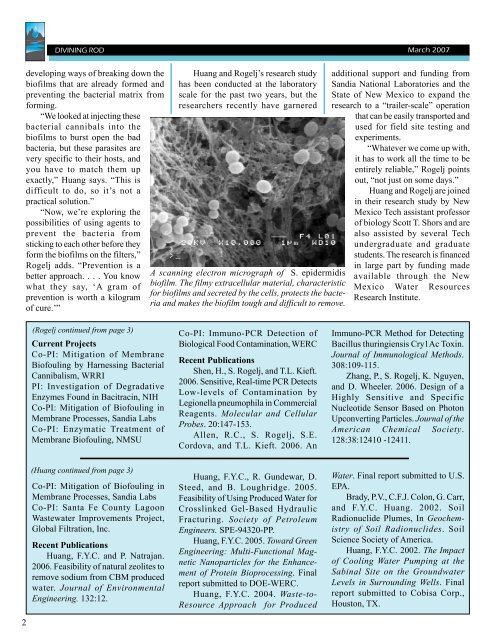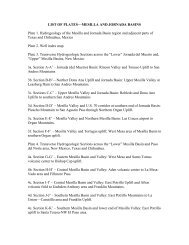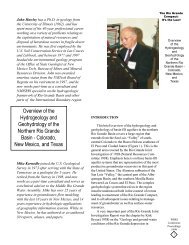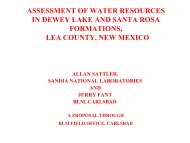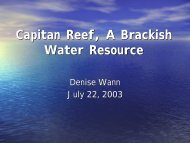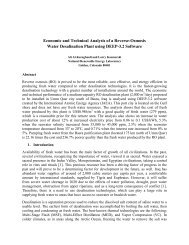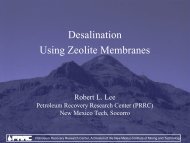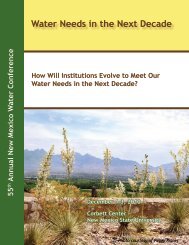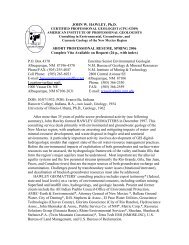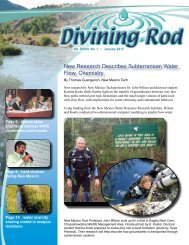Vol. XXX, No. 1 - Water Resources Research Institute - New Mexico ...
Vol. XXX, No. 1 - Water Resources Research Institute - New Mexico ...
Vol. XXX, No. 1 - Water Resources Research Institute - New Mexico ...
Create successful ePaper yourself
Turn your PDF publications into a flip-book with our unique Google optimized e-Paper software.
developing ways of breaking down the<br />
biofilms that are already formed and<br />
preventing the bacterial matrix from<br />
forming.<br />
“We looked at injecting these<br />
bacterial cannibals into the<br />
biofilms to burst open the bad<br />
bacteria, but these parasites are<br />
very specific to their hosts, and<br />
you have to match them up<br />
exactly,” Huang says. “This is<br />
difficult to do, so it’s not a<br />
practical solution.”<br />
“<strong>No</strong>w, we’re exploring the<br />
possibilities of using agents to<br />
prevent the bacteria from<br />
sticking to each other before they<br />
form the biofilms on the filters,”<br />
Rogelj adds. “Prevention is a<br />
better approach. . . . You know<br />
what they say, ‘A gram of<br />
prevention is worth a kilogram<br />
of cure.’”<br />
Huang and Rogelj’s research study<br />
has been conducted at the laboratory<br />
scale for the past two years, but the<br />
researchers recently have garnered<br />
A scanning electron micrograph of S. epidermidis<br />
biofilm. The filmy extracellular material, characteristic<br />
for biofilms and secreted by the cells, protects the bacteria<br />
and makes the biofilm tough and difficult to remove.<br />
additional support and funding from<br />
Sandia National Laboratories and the<br />
State of <strong>New</strong> <strong>Mexico</strong> to expand the<br />
research to a “trailer-scale” operation<br />
that can be easily transported and<br />
used for field site testing and<br />
experiments.<br />
“Whatever we come up with,<br />
it has to work all the time to be<br />
entirely reliable,” Rogelj points<br />
out, “not just on some days.”<br />
Huang and Rogelj are joined<br />
in their research study by <strong>New</strong><br />
<strong>Mexico</strong> Tech assistant professor<br />
of biology Scott T. Shors and are<br />
also assisted by several Tech<br />
undergraduate and graduate<br />
students. The research is financed<br />
in large part by funding made<br />
available through the <strong>New</strong><br />
<strong>Mexico</strong> <strong>Water</strong> <strong>Resources</strong><br />
<strong>Research</strong> <strong>Institute</strong>.<br />
(Rogelj continued from page 3)<br />
Current Projects<br />
Co-PI: Mitigation of Membrane<br />
Biofouling by Harnessing Bacterial<br />
Cannibalism, WRRI<br />
PI: Investigation of Degradative<br />
Enzymes Found in Bacitracin, NIH<br />
Co-PI: Mitigation of Biofouling in<br />
Membrane Processes, Sandia Labs<br />
Co-PI: Enzymatic Treatment of<br />
Membrane Biofouling, NMSU<br />
Co-PI: Immuno-PCR Detection of<br />
Biological Food Contamination, WERC<br />
Recent Publications<br />
Shen, H., S. Rogelj, and T.L. Kieft.<br />
2006. Sensitive, Real-time PCR Detects<br />
Low-levels of Contamination by<br />
Legionella pneumophila in Commercial<br />
Reagents. Molecular and Cellular<br />
Probes. 20:147-153.<br />
Allen, R.C., S. Rogelj, S.E.<br />
Cordova, and T.L. Kieft. 2006. An<br />
Immuno-PCR Method for Detecting<br />
Bacillus thuringiensis Cry1Ac Toxin.<br />
Journal of Immunological Methods.<br />
308:109-115.<br />
Zhang, P., S. Rogelj, K. Nguyen,<br />
and D. Wheeler. 2006. Design of a<br />
Highly Sensitive and Specific<br />
Nucleotide Sensor Based on Photon<br />
Upconverting Particles. Journal of the<br />
American Chemical Society.<br />
128:38:12410 -12411.<br />
(Huang continued from page 3)<br />
Co-PI: Mitigation of Biofouling in<br />
Membrane Processes, Sandia Labs<br />
Co-PI: Santa Fe County Lagoon<br />
Wastewater Improvements Project,<br />
Global Filtration, Inc.<br />
Recent Publications<br />
Huang, F.Y.C. and P. Natrajan.<br />
2006. Feasibility of natural zeolites to<br />
remove sodium from CBM produced<br />
water. Journal of Environmental<br />
Engineering. 132:12.<br />
Huang, F.Y.C., R. Gundewar, D.<br />
Steed, and B. Loughridge. 2005.<br />
Feasibility of Using Produced <strong>Water</strong> for<br />
Crosslinked Gel-Based Hydraulic<br />
Fracturing. Society of Petroleum<br />
Engineers. SPE-94320-PP.<br />
Huang, F.Y.C. 2005. Toward Green<br />
Engineering: Multi-Functional Magnetic<br />
Nanoparticles for the Enhancement<br />
of Protein Bioprocessing. Final<br />
report submitted to DOE-WERC.<br />
Huang, F.Y.C. 2004. Waste-to-<br />
Resource Approach for Produced<br />
<strong>Water</strong>. Final report submitted to U.S.<br />
EPA.<br />
Brady, P.V., C.F.J. Colon, G. Carr,<br />
and F.Y.C. Huang. 2002. Soil<br />
Radionuclide Plumes, In Geochemistry<br />
of Soil Radionuclides. Soil<br />
Science Society of America.<br />
Huang, F.Y.C. 2002. The Impact<br />
of Cooling <strong>Water</strong> Pumping at the<br />
Sabinal Site on the Groundwater<br />
Levels in Surrounding Wells. Final<br />
report submitted to Cobisa Corp.,<br />
Houston, TX.<br />
2


